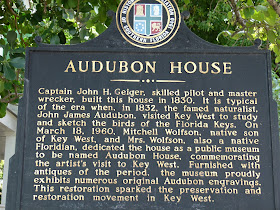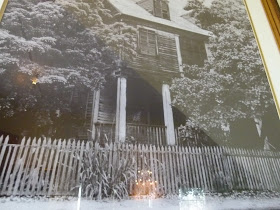 |
| Audubon |
 |
| Capt. Geiger |
 |
| The rear of the Audubon house. |
If you didn't know already, John James Audubon was one of America's leading naturalists and artists. He was a serial adventurer - over a 10 year period he traveled widely to paint the 435 plates in the book The Birds of America. When in Key West and the Florida Keys in 1832 he painted 21 of the 435 plates. He painted in the gardens of this house (although at the time it was a rough mix of sand and cactus and rough shrubs - not the manicured garden it is today). At the time the only structure on this site was a single story shack and Audubon slept on his boat, not here.
There are various original engravings here and all 21 engravings of the birds he painted here. In addition, there are snippets of the notes he took which are a fascinating glimpse into the natural history of the Keys back then.
All the original engravings displayed in this house are amazingly beautiful and you can buy some of them (not originals - they sell for millions!) in the shop next door for a few hundred dollars.
Capt. Geiger
There were 600 dwellings in Key West before the 1830s storm; after the storm only 8 survived. The single story dwelling here before did not survive. So this house was born out of a storm.
Geiger was a rich, very successful captain who made his money through wrecking. He had shares in at least 6 salvage boats. In this house was 9 children and 11 slaves and, being the social hub of KW, loads of sailors and other guests. Geiger got the house built from termite resistant pine and by boat builders - he wanted it to last. Finished in the 1840s, it has.
He was one of the richest men in town. Hence the amazing house and contents, here on display. This was one of the richest men in town, when KW was the richest town in the USA. However, he loved to show off and also spend lots of money. So he died poor.
Here is his house:
Restoration and the garden
There's actually a third player in this story. By 1960 the house was in ruin (see below picture). Cosmetically, anyway. The structure was fine. That's when Frances Wolfson started to restore it and sparked the entire restoration movement in Key West. That's visionary.
Today the house looks magnificent, the gardens beautiful and the volunteers excellent.

























No comments:
Post a Comment
Please feel free to leave a comment - would love to hear from you.....No spam/links - I delete them all